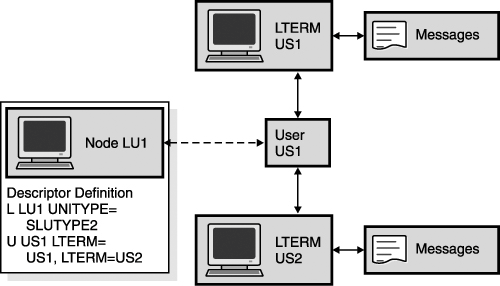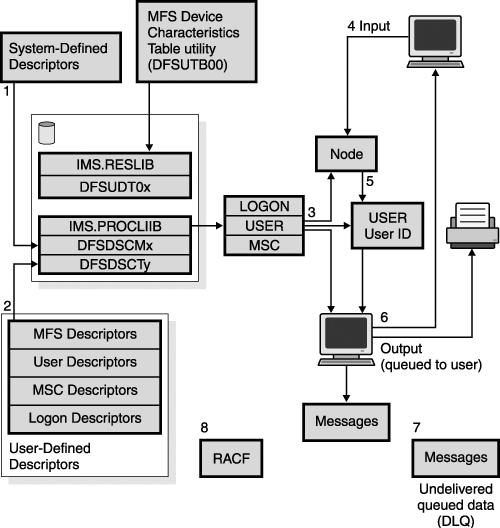The Extended Terminal Option (ETO)
| The IMS Extended Terminal Option (ETO) allows you to dynamically add VTAM terminals and users to your IMS: they do not need to be predefined during system definition. ETO is a separately priced feature of the IMS Transaction Manager (TM) and provides additional features such as output security, automatic logoff, and automatic signoff. By using ETO, you can achieve each of the following goals:
Related Reading: For more information about ETO, see IMS Version 9: Administration Guide: Transaction Manager. ETO TerminologyThe following sections describe the terms that have ETO-specific meanings. These meanings are important for understanding ETO. TerminalsA terminal is a physical VTAM logical unit (LU) that establishes a session with IMS. A physical terminal is represented using a control block. When a terminal is not built by ETO but is defined at system definition, it is called a static terminal. A static terminal can be a VTAM node. When messages are sent to a static terminal they are queued to a logical terminal (LTERM) message queue, where they await retrieval by the recipient. When a terminal is not defined at system definition and ETO builds a terminal, that terminal is called a dynamic terminal, or an ETO terminal. For dynamic terminals, the logical terminal (LTERM) is known as a dynamic user message queue, and the LTERM associates the messages with the user, rather than with the physical terminal. Associating messages with the users provides more security for these users, because they can access their messages only when they sign on using their unique user ID. In addition, all users in the network can access their messages from any physical terminal, instead of being restricted to using a particular physical terminal. Dynamic UserA dynamic user is a user who signs on to a dynamic terminal and who has a unique identification (user ID) that IMS uses for delivering messages. The user is usually associated with a person but can also be associated with another entity, such as a printer. Terminal StructureA terminal structure is a control block that represents a specific terminal that is known to IMS. A terminal structure is created when the individual terminal logs on to IMS and is deleted when the terminal logs off with no remaining associated activity. User StructureA user structure is a set of control blocks, including a user block and one or more LTERM blocks. The message queues are associated with the dynamic user, as opposed to the physical terminal, and they are queued to the user ID. Usually, a user structure represents a person who uses IMS. The dynamic user structure connects to the physical terminal only when the user signs on. This provides a secure environment, because different users accessing the same terminal cannot receive each other's messages. IMS creates a user structure when either of the following events takes place:
The user structure name is usually the same as the user ID. A user structure can also represent a logical destination, such as a printer. In this case, the user structure name can be the same as or different from the LTERM name that your installation uses in its application programs and its exit routines. For example, you can assign the same name to a user structure for a printer that you assign to its LTERM destination node name. However, output is then queued according to the terminal, and not to the user. Figure 19-3 illustrates: Figure 19-3. Static Resources: Node and Static Terminals
Figure 19-4 illustrates: Figure 19-4. ETO Dynamic Resources: User and Dynamic Terminals
DescriptorsA descriptor provides information to IMS when IMS builds a dynamic resource for a logon or a signon. IMS stores the descriptors in two IMS.PROCLIB members, DFSDSCMx and DFSDSCTy. For more information about these PROCLIB members, see IMS Version 9: Installation Volume 2: System Definition and Tailoring. IMS uses four types of descriptors:
Logon DescriptorsA logon descriptor is a skeleton that IMS uses to build an ETO dynamic terminal. It provides information regarding a terminal's physical characteristics. IMS uses logon descriptors in conjunction with exit routines to create terminal structures. IMS uses three types of logon descriptors: Generic
Group
Specific
Recommendation: Although you might need to use specific logon descriptors during the actual migration to ETO, use generic logon descriptors or group logon descriptors after you have migrated to ETO; these types of descriptors ease network administration. User DescriptorsA user descriptor is a skeleton from which IMS builds a user structure. A user descriptor can provide user options and queue names. MSC DescriptorsIMS uses an MSC descriptor to create a remote LTERM, which is an LTERM that does not exist on the local IMS. The physical terminal definition (either static or dynamic) for the remote LTERM is in the remote IMS. Each MSC descriptor for a remote LTERM is loaded during IMS initialization and tells IMS which MSC link to use for output destined for that remote LTERM. MFS Device DescriptorsAn MFS device descriptor allows you to add new device characteristics for MFS formatting without requiring an IMS system definition. The MFS Device Characteristics Table utility (DFSUTB00) uses MFS device descriptors to update default formats in the MFS library. IMS also uses MFS device descriptors to update the MFS device characteristics table. IMS loads this table only during initialization; therefore, updates are not effective until the next IMS initialization. How Structures are Created and UsedStructures are created in the following situations:
In all cases, IMS searches for an existing terminal or user structure before creating a new one. IMS creates and deletes user structures in the following sequence:
This sequence applies only to terminal logon and logoff and to user signon and signoff. When asynchronous output is queued to a user, IMS creates the user structure, as needed. Related Reading: For more information about the Resource Manager, see "Resource Manager" on page 498 or IMS Version 9: Common Service Layer Guide and Reference. For more information about how IMS manages terminal and user structures, see IMS Version 9: Administration Guide: Transaction Manager. Descriptors and Exit RoutinesUsing descriptors and exit routines, you can assign characteristics to dynamic terminals and assign user structures to be associated with those dynamic terminals. A descriptor provides the basic information for the dynamic terminal. An exit routine completes or changes this information. Two methods of using descriptors and exit routines are:
How Descriptors Are Created and UsedAll descriptors are created during IMS initialization, prior to IMS startup. You must specify that you want ETO support and ensure that the ETO initialization exit routine (DFSINTX0) does not disable ETO support. During IMS initialization, IMS reads and validates all ETO descriptors. IMS initialization then continues, and the descriptors remain in storage for the duration of IMS execution. Any changes you make to descriptors become effective after the next initialization of IMS. IMS uses descriptors to create both terminal and user structures. IMS rebuilds structures during an IMS restart, if appropriate. For example, if messages are queued for a structure and IMS shuts down, the structures are rebuilt when IMS restarts. IMS rebuilds these structures to be the same as they were before the IMS restart. IMS does not use the descriptors or exit routines to rebuild these structures. Therefore, any changes you make to descriptors are only reflected in new structures that are built after IMS restart, and the changes are not reflected in structures that are rebuilt during IMS restart. Example USERA signs on using descriptor DESCA, which specifies an auto signoff time of 20 minutes (ASOT=20). USERA starts an IMS conversation, and then IMS abnormally terminates. The system programmer changes DESCA to ASOT=10. After the IMS restart, USERB signs on using DESCA. USERA's structure was rebuilt during the IMS restart. USERA still has a value of 20 minutes for the auto signoff time (ASOT=20), and USERB has a value of 10 minutes for the auto signoff time (ASOT=10). Summary of ETO ImplementationFigure 19-5 on page 345 shows an overall view of an ETO implementation. The steps that follow correspond to the highlighted numbers in Figure 19-5. Figure 19-5. Summary of ETO Implementation
|
EAN: 2147483647
Pages: 226


